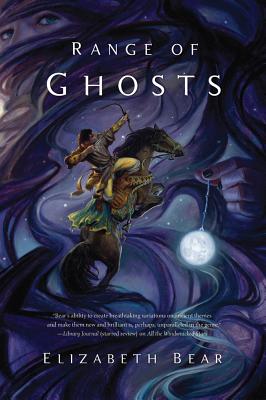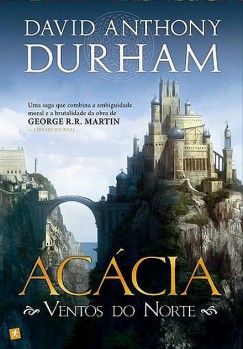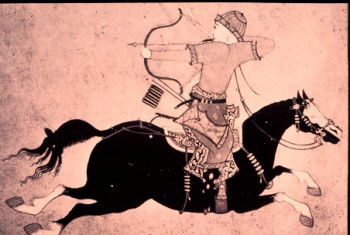Range of Ghosts
 I’ve always wanted to write an epic fantasy.
I’ve always wanted to write an epic fantasy.
A real epic fantasy, something with sweep and scope, tumbling empires, wizards and warlocks, monstrous fantastical beasts and horses of supernatural speed and stamina and crooked old gods vying for power. Something in the sword-and-sorcery mode, but not exactly a Leiberesque low fantasy… or a Tolkienesque high fantasy either. Rather, a book–a series of books, really, because what I had in mind wouldn’t fit in a hundred and fifty thousand words or so–in which the fate of kingdoms hung in the balance, but which wasn’t uncritical of the role of kings.
I wanted to write a book that had the sense of scope and sense of wonder of the books I loved as a young adult… but I kept running into the same problem.
There’s so much epic fantasy out there. And so much of it looks strangely similar. Not identical, of course… but like different chefs’ versions of the same recipe. The ingredients are all the same.
I’m a fan of Guy Gavriel Kay’s Fionavar books, for all their slightly string-pulling manipulativeness. I love the way he takes every possible overplayed trope of fantasy and dumps them all into the same pot–and then pokes them with sticks and makes them fight. But I knew I didn’t want to do that. I wanted a narrative with elements of quest in it, but not simply a quest to reclaim or destroy the magic widget that makes the story go. I wanted a book that would shift scenes from city to city, from culture to culture — and I knew I wanted a world that wasn’t inhabited by nothing but Europeans.
In fact, I was pretty sure I wanted to dispense with the Europeans all together.
In the meantime, I was researching Central Asia and North Africa and their border cultures, and trying to come up with my own world inspired by those settings but not too derivative of them. I didn’t want to write a historical fantasy — or even an ahistorical fantasy, like Conan, which purports to take place in the antediluvian history of our own earth. I very much wanted a fantasy world, it’s own place, with a few thousand years of history as backdrop.
This was one of the tools I wanted to use to interrogate fantasy monarchism a little bit. Too often, fantasy relies upon eternal empires, which must be maintained at all costs against the forces of chaos. But in the real world, empires fall – -and that’s not always a bad thing. A mature empire is a stagnant thing, and it’s hard in this modern world to ignore the implications of conquest, colonialism, and oppression that come with the act of building empires.
 In the rise and fall of the empires of the Steppes, I saw my opportunity. These cultures — from Scythian to Mongolian — are largely ignored in western-focused history, or are cast as the villains — and in western fantasy they have largely been treated that way.
In the rise and fall of the empires of the Steppes, I saw my opportunity. These cultures — from Scythian to Mongolian — are largely ignored in western-focused history, or are cast as the villains — and in western fantasy they have largely been treated that way.
I started playing with some of the ideas in this settling in 2005 or so, and wrote a brief short story — “Love Among the Talus,” which explores one aspect of the setting: the westernmost reaches of an empire strongly modeled on the Mongolian Khanate — in early 2006.
After that, there was a lot of slow research. Picking ideas up, putting them down. Revisiting some of the classics of fantasy, and exploring some of the new trendsetters — from Howard’s Conan stories through J.R.R. Tolkien to Durham’s Acacia with stops at Brust and Feist and Jemisin and Lynch and Rothfuss along the way — all the signposts of what I half-lovingly, half-exasperatedly refer to as Fat Fantasy With Maps.
So I started looking for what made the ones that were different… different.
The influences on this work are myriad, and begin with the beloved books of my childhood: Conan, of course, but also Jessica Amanda Salmonson’s three-volume retelling of the life of Japan’s legendary female samurai Tomoe Gozen, which at one point I read until the covers fell off.
Leiber, but I wanted something with more scope than the Fafhrd and Gray Mouser tales — something with a sense of empire and history. Tolkien, but not just Tolkien, because while I wanted a heroic aspect — not the straight rejection of heroic narrative that comes with George R.R. Martin and his literary descendents, such as Joe Abercrombie. But I didn’t want an uninterrogated heroic narrative either.
Since I have four names anyway, I contemplated changing my middle initials to R.R. Just as a little bit of sympathetic magic.
Cooler heads prevailed.
Moorcock is of course an influence, but I didn’t want to write something that dark. Poul Anderson was probably closest to the mark I was aiming at — humane, accepting of the horrors of war, but also capable of acknowledging the potential for greatness of the human spirit — and its indomitable stubbornness, which is my favorite thing about Tolkien. His people just. Keep. Plugging. Away.
It’s all very admirable — and very British. “Keep calm and carry on” carried to the end of the world.
Also, not quite the mode in which I write, although I have a lot of respect for grit and grim determination.
 And then one day — it was June 10th, 2009, because I mentioned it in my blog — I opened up a fresh document and typed the following line: “Ragged vultures spiraled up a cherry sky.”
And then one day — it was June 10th, 2009, because I mentioned it in my blog — I opened up a fresh document and typed the following line: “Ragged vultures spiraled up a cherry sky.”
The book didn’t have a title, or even — really — a plot, yet. It had no antagonist, no female lead. (Now it has both!)
But what I did have was a mental image of a young man, grievously wounded, staggering across an endless battlefield. It was an image in part drawn from family legend about the exploits of my Cossack great-grandfather, an immigrant from Ukraine and probably a descendant of Mongols himself (the Cossacks claim descent from the Golden Horde, and it’s not unlikely). And that image stayed with me through the writing of the nearly six hundred pages that followed.
The book has a title now — Range of Ghosts. It’s the first in a trilogy called The Eternal Sky. It has beautiful Donato cover art and a gorgeous hand-drawn map inside, making it an official Fat Fantasy With Maps.
And a little less than three years later, I have an early copy that I can hold in my hand.
The bit about the vultures is still the first line.
[…] Here’s an essay at Black Gate, about how I always wanted to write an epic fantasy–and no… […]
Beautiful post Elizabeth (if I may). And opening sentence. Your description of what you sought to write and what you’ve done to foster and grow that desire is inspiring, delightful, and engrossing. It also entices me to read your tale.
Thank you for sharing.
Interesting exploration of your thought process, your intellectual desires, as you developed your Fat Epic Fantasy with Maps.
I’ll have to check it out when I get the time.
Wonderful to see you here, Bear! I can’t wait to see what you do with the epic. And thank you for pointing me toward Tomoe Gozen. She’s exactly the serendipitous history find I needed today.
Since I also weave non-European High Fantasy tales, I intend to ravish this book with my eager fingers.
Kate Elliott’s Jaran series has done what you say you want to do with these cultures and historical eras — though she propelled them into the future, a somewhat hybrid sf/f series.
Historical fiction has been using these periods and cultures for quite awhile, so much so, many current authors using them have ignored certain historicity and historical facts (as far as they are known) and included elements that are common to fantasy fiction too.
Congratulations, Elizabeth. So much good stuff coming out lately. Putting yours on my list.
[…] herself also has an interesting take on the Fantasy genre and some of the ideals that led to her deciding to write her first Epic Fantasy: I’m a fan of Guy […]
[…] March Elizabeth Bear visited to tell us a little about her new fantasy novel, Range of Ghosts. And it sure sounded terrific — […]